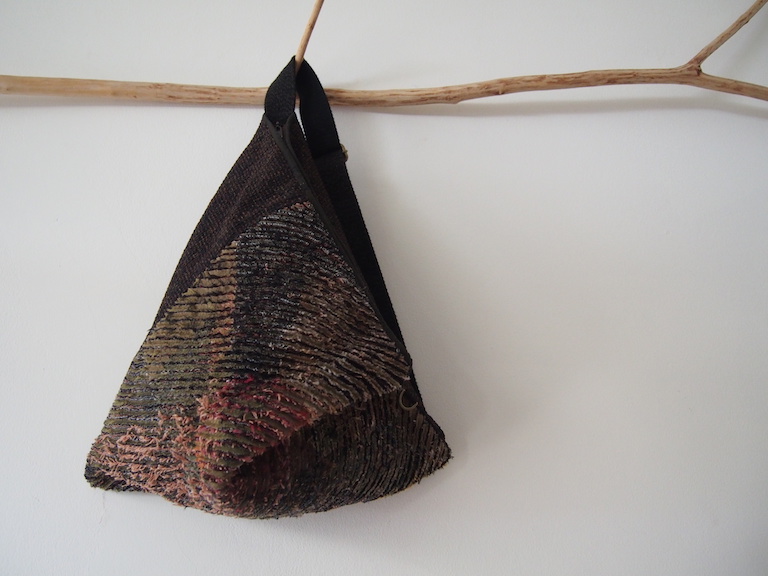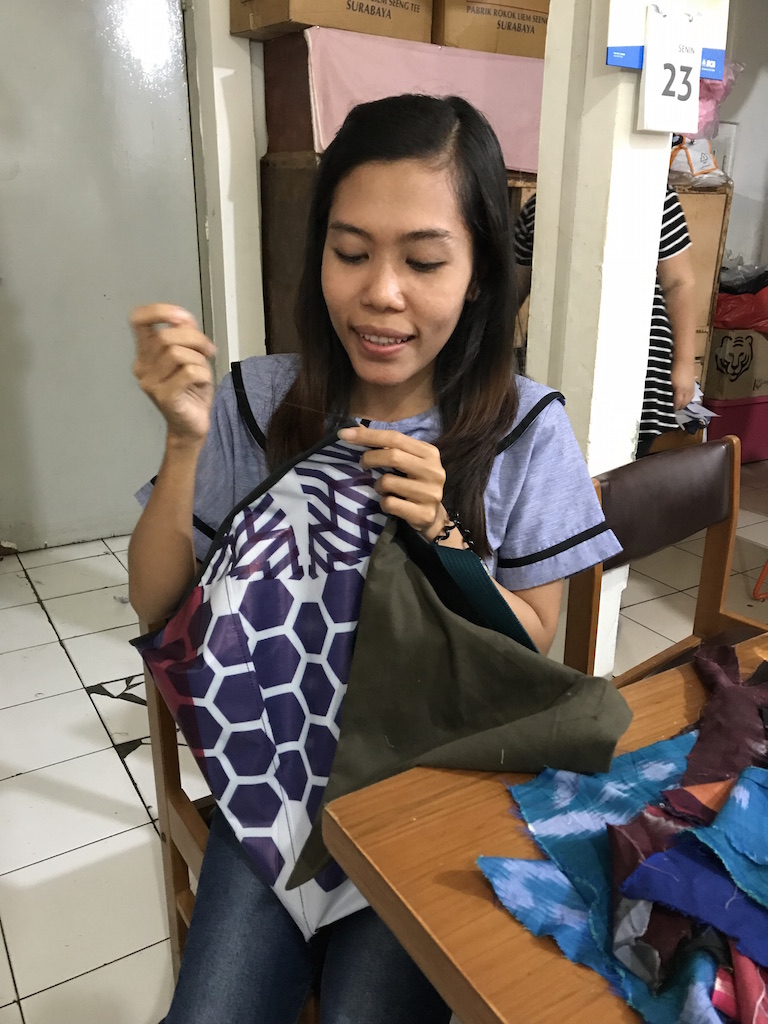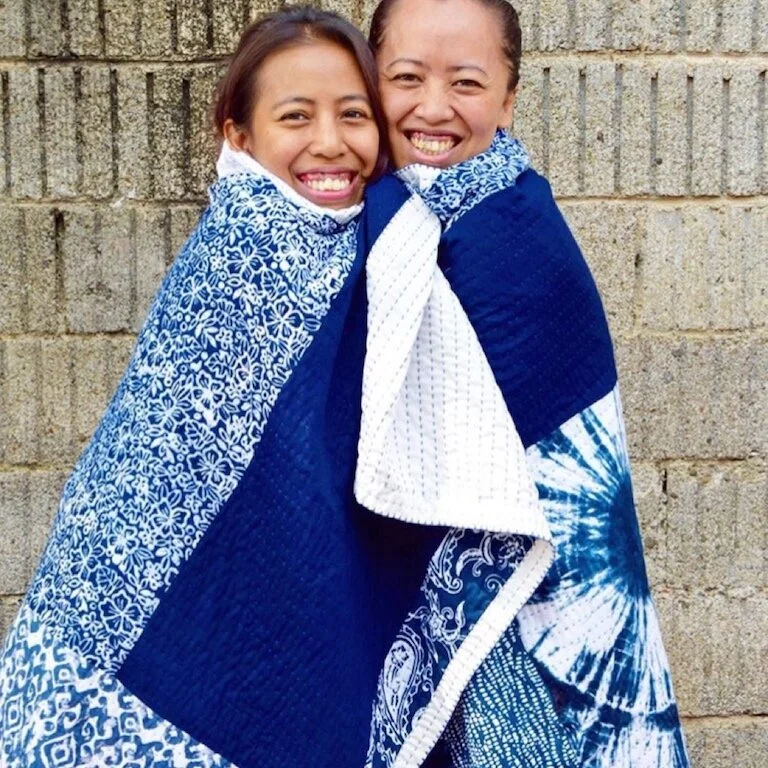Threadapeutic - Making a Difference Through Fabric Upcycling
Founded in 2015 by Ibu Nagawati Surya, Threadapeutic is based on the concept of making products out of waste, in particular fabric offcuts, and turning them into items of value. My first encounter with Threadapeutic was at The Rooftop Market (now known as The Local Market). I recall being drawn to the unique design of the products, as well as the curiously tactile fabric. Upon further investigation, I discovered the story behind each item including the process of making the bespoke fabric as well as the important values that are woven into each piece.
Both Liz and I knew this was a story that we needed to investigate further and ultimately share with you, our blog readers. So just this past week, we ventured out to Slipi in West Jakarta to visit Ibu Hana (Nagawati prefers this name) along with her team. And today we present you with the story of Threadapeutic - a tale of hope, inspiration and genuine care for humanity and our planet.
Happy Reading :)
*Kenalkan Ibu Nagawati Surya, ‘Hana’
Ibu Hana (Photograph by Threadapeutic)
Hana, can you please share with us a bit about your background
I was born in Surabaya, then moved with my parents to Banjarmasin (the capital of South Kalimantan) when I was five. At the age of nine I was sent abroad to Singapore to study. I completed my GCE O’ level in Singapore and then in 1982 I moved to Los Angeles to continue my study, graduating from Pepperdine University in 1987. The following year I moved to Jakarta and shortly after I married. I have 3 daughters and they are currently residing in Singapore.
Ibu Hana with her family (Photo by Threadapeutic)
How did the idea for ‘Threadapeutic’ evolve?
The idea started after I successfully completed an assignment to create souvenirs for a major fashion event using abundant fashion waste materials and post-event banners provided by the event organiser. It made me realise how much waste our local fashion industry creates! Thus Threadapeutic was established with the sole focus of being conscious of our purchases in this mass producing world.
Photograph by Threadapeutic
What’s in a name, why ‘Threadapeutic’?
I used to learn to sew from my mother, who was a seamstress, when I was very young. She passed away when I was 11 years old. As I grew up abroad, I used to mend my own clothing by hand, or shorten store bought pants etc. During those quiet sewing times, I felt close to my mother. It was always a soothing, comforting time for me. So this is how Threadapeutic came about; threads/sewing is therapeutic. And it was my daughter, Karen, who helped me stitch the 2 words together to become a word that means a lot to me, Thread-a-peutic.
Who makes your Threadapeutic fabric and products?
Our team is a very eclectic mix of people including a former sales girl, a housewife, a lady who is both speech and hearing impaired, a senior seamster and a young girl who was once trained to be a fashion designer.
Ibu Hana with her team including (from back left-right): Jeanne-Angelina, Hamideh, Suryati and Fitri; and front - Lastriah and Pak Kusworo
Pak Kusworo has been working as a tailor for over twenty years
Ibu Lastriah inserts the lining in a tote bag
Is the method that you use to create your signature 'chenille-style' fabric your own concept or is it an existing technique?
We are using a technique commonly used by fashion designers called fabric manipulation/monumental textile; or making faux chenille fabric. The Japanese call it making ‘slash quilt’. As most people commonly use new fabric to make slash quilt, we use this technique to upcycle fabric scraps/offcuts, even worn or old fabric can be used, including old car seat covers!
The process of making Threadapeutic's signature fabric takes time and patience. Once all the fabric offcuts have been washed and ironed, they are then selected and pinned together in layers, ready for hand-stitching. This is followed by machine sewing and the fabric is then carefully cut to reveal the layers beneath. To create the 'chenille-effect' the fabric is brushed to encourage the fibres to become free.
A close up of the chenille-like fibres in this Threadapeutic wall hanging (Photograph by Threadapeutic)
Can you give us an oversight of the fashion industry, in particular the amount of waste generated and the way that fabric waste is disposed of?
The fashion industry is producing way beyond what we really need. Fashion designers are dictating what fashion is in and what’s out in order to create constant demand for new sales. Obviously this means that there is a much greater demand for more resources, both organic and non-organic. But what happens to the offcuts, waste and unsold stock? As people become more educated and more conscious about their spending, as well as aware of how things are made, people will purchase only what they need and (hopefully) items that are of good lasting quality.
Much care and attention to detail is taken in the making of Threadapeutic fabric and the assembly of each product. Here Ibu Hamideh prepares the ends of a zip before sewing it into place in a purse
Locally, most fabric scraps, especially the cheap, poorly designed fabric is usually dumped as waste, as very few companies are willing to upcycle or recycle due to high cost. Sadly, it is still cheaper to buy mass produced fabric whose production most likely has no concern for environmental impact.
Many would see the waste problem as too large - Why do you care?
I care for the sake of our next generation. I am concerned about depleted resources and environmental pollutions. What kind of planet will future generations experience, if we, right now, are not concerned about how our present actions are impacting?
What has your upcycled fabric been used for?
Our fabric has been used in various ways including interior soft furnishings like cushion covers as well as wall hangings, table runners and even containers. And for fashion, it is mainly used for bags and scarves.
Chenille-style throw (Photograph by Threadapeutic)
IPad or Computer pouch (Photograph by Threadapeutic)
Photograph by Threadapeutic
Where do you seek your inspiration?
We most commonly refer to Pinterest and other upcycling websites for inspiration but in reality, ideas and inspiration can simply come from a need. With an abundance of waste at our disposal, we have to come up with ideas on how to make use of this.
The dumpling bag by Threadapeutic
How do you source your fabric offcuts and other materials?
The majority of our fabric is donated by garment makers including the fashion label xsml, as well as individual tailors and seamstresses. We receive coffee beans sacks (goni sacks) from coffee roasters as well as post-event banners from event organisers. When we need bigger pieces of fabric, we source leftovers from garment factories. Normally they sell by the kilo.
A drawstring bag made from goni fabric (coffee sacks) and reclaimed denim (Photograph by Threadapeutic)
Ibu Suryati sews a tote bag made from recycled plastic promotion banners
Do you accept fabric and fabric offcuts from the community?
Yes, from just about anyone who wants to give away fabric offcuts, including discontinued upholstery samples. Of course we would love to receive any fabric your readers may have spare. They just need to contact me on +62 821 11855912 or drop off their donation to our Palmerah workshop (details below).
Fabric offcuts (Photograph by Threadapeutic)
Ibu Fitri irons the fabric offcuts before they are transformed into new fabric and given a new life
Ibu Fitri at the Threadapeutic workshop in Slipi, West Jakarta
Can you tell us about any current collaborations in which Threadapeutic is involved?
Threadapeutic and I Made This campaign have teamed up to create a collaboration with a cause. With no opportunity to enter the workforce or attend school formally, refugees in Indonesia are in a state of uncertainty. This collaboration has given the refugee community of Indonesia a new sense of purpose as well as hope of better things to come. Some members of the refugee community in Bogor, Indonesia are making upcycled bags as well as jewellery and selling them at selected local markets including The Responsible Market @komunal88 and The Local Market. Our partnership with I Make This campaign aims to spread the notion of an inclusive community, while also putting Indonesia on the map as a creative and environmentally conscious society.
Where to with Threadapeutic - Future plans?
We would like to build a training camp where people can come to learn about our upcycling and techniques; and carry out upcycling experimentation. Here they could learn from each other and in turn teach others.
Ibu Jeanne-Angelina sorts through pieces of chenille-style fabric ready for a 'decorate your own bag' workshop scheduled for the day after we visited
The idea is that it is a homestay as well as a place where our guests can do upcycling workshops. We would work with communities and schools to provide upcycling skills as a way to empower needy individuals.
Where can our ajb readers source your beautiful products and how is it best to follow your journey?
To purchase our products, we recommend that you check out www.kuka.co.id/threadapeutic and also facebook.com/threadapeutic or come to our special bazaar events like The Local Market Indonesia for the complete range of new products. Follow us on Instagram or Facebook so that you don’t miss out!
In Profile - Hana’s Jakarta
3 words to describe Your Jakarta: Busy, Metropolitan, Change
To experience the true essence of Jakarta, a visitor to this city must…(3 suggestions)
Visit the Old Town of Batavia
Eat the local food
Walk to experience the true sights and sounds of Jakarta.
Do you prefer Tea or Coffee and where do you like to sip your favourite beverage?
I usually enjoy my tea at a place that I wind down at the end of the day, ie, my home. I normally have my coffee at breakfast time, but I also like One Fifteenth Coffee or any place convenient at Plaza Senayan like Garçon for my social coffee and desserts.
Can you tell us your favourite 3 Indonesian dishes/snacks and where you source them in Jakarta?
Grilled oxtail soup at An Resto Gading Batavia
Nasi liwet in the evening at Kelapa Gading Permai Apartment parking lot
Makassar’s crispy noodle at Pelangi Kelapa Gading.
Where is your preferred place to relax in Jakarta?
Best place to relax is my own home :)
Your favourite music - Tracy Chapman, Eric Clapton, Edie Brickell
Where do you find hidden gems in Jakarta - to eat, to drink and to visit
Small alleys in Pancoran
And finally, can you suggest 5 ways that our ajb readers can become a part of the Threadapeutic journey:
1. Donate any spare fabric to the Threadapeutic workshop (fabric of all shapes, sizes and colours will be accepted)
Fabric of all shapes, sizes and colours are accepted - including discontinued upholstery samples pictured here
2. Purchase Threadapeutic items as gifts - This will be a gift that will give many times over. A great idea for Christmas!
3. Follow the Threadapeutic journey on Instagram and keep up to date with events such as markets and Threadapeutic workshops
Sign up for a workshop by following Threadapeutic on FB or Instagram (Photograph by Threadapeutic)
4. Spread the Word! Share the Threadapeutic story with your family and friends. Help raise awareness of the importance of supporting local communities; the importance of slow fashion and the need to make sound decisions regarding our purchases. A simple conversation about these concepts can have a profound impact.
5. Do You have skills in design, or knowledge in fabric upcycling techniques? Why not share your expertise with Threadapeutic. Hana and her team are always receptive to new ideas and would love to hear from you :)
Threadapeutic Workshop (for fabric donations)
Jl. Palmerah Utara No.28
Slipi
West Jakarta 11480
*Kenalkan - Let me introduce..
Meeting the Threadapeutic team at their workshop in Slipi, West Jakarta
Interested in stories that are all about making a difference to people and our planet? We invite you to check out these posts:
Rubbish in Jakarta - The Mounting Problem and the Ffrash Solution
Stylish and Ethical Home Decorating with Paisley Things
Words: Jo Stevens Photography: Threadapeutic and a journey bespoke



























